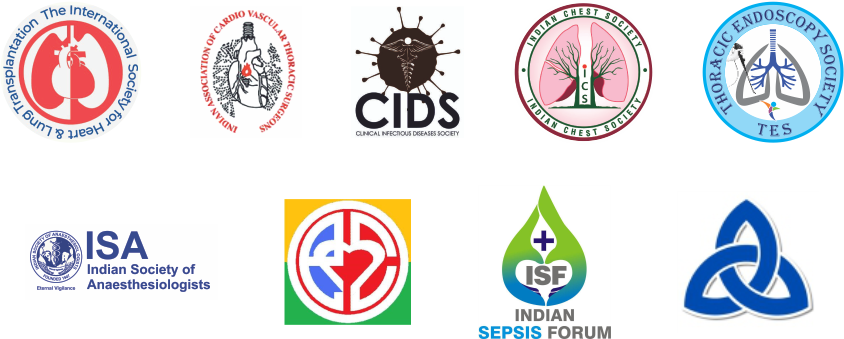Abstract Submission Guidelines
Please load all presentations in the preview room, preferably on the day prior to presentation, but certainly at least 2 hours before presentation. Podium loading and use of personal laptops/ Pen drives is strictly prohibited.
For PPTX, please choose a dark background with white or light shade fonts for better projection.
| Award paper Presentation |
|
|
| Free paper Presentation |
|
|
| Video Presentation |
|
|
| Innovations in Thoracic Organ Transplant |
|
|
| E-Poster Presentation |
|
|
IMPORTANT DATES
- Online E-Poster / Video Poster Submission Open: 1st May 2025.
- Online E-Poster / Video Poster Submission Deadline: 31st Aug. 2025.
- Award paper, Free paper, Video, Innovations, E-Poster Presentation in Thoracic Organ Transplantation
- Submission portal will open from 1st May 2025.
- Last date to submit E-Poster is 31st Aug. 2025
GUIDELINES FOR ABSTRACT SUBMISSION
-
Language:
- Underline 'Presenting author'
- Presenting author’s contact details; phone number and email address.
- Name(s) of presenting author and co-authors: first name(s), surname (e.g. JagdishGupta).
- Author (s) names must be in upper and lower case (Jai Kishan Mathur).
- Corresponding author’s name and contact details for communication.
- All authors should be listed in Vancouver style, please check any old IJTC issue.
- Name of the institution affiliated.
- Abstracts – No generic statements like “Data/Results shall be presented” etc. shall be acceptable. Hard Data summary will have to be provided upfront, otherwise abstracts will not be considered for presentation in any format.
- Conference registration is mandatory to present the paper in the conference
All abstracts must be written exclusively in English (including the title, abstract text, authors names, affiliations).
-
Abstract for original article (structured) should include:
- Aim/Objective(s)
- Material and method
- Result(s)
- Conclusion
- Word limit for abstract: 350 words.
- Do not include references in the abstract.
Use only standard abbreviations. Special or unusual abbreviations are not recommended. If otherwise necessary, the latter should be placed in parenthesis after the first appearance of the full word, except for unit symbols. Numeral rather than words may be used to indicate numbers.
GUIDELINE FOR MANUSCRIPT PREPARATION
- Word limit 5000 (excluding references), 40 references maximum, not more than 10 tables/figures.
- Original Articles must follow IMRaD format.
- Methodology must include specifically:
- Type of the study.
- How was the sample size calculated?
- What is the power of the study?
- Method of randomization
- Inclusion/ Exclusion criteria
- Primary and Secondary endpoints should be clearly defined
- Separate section on "Statistical Analysis" clearly defining in details the tests and tools used to analyze data.
- Aims of the study should be under a separate head.
- Limitations of the study need to be dwelled in great details under a separate heading.
- Review of literature should be up-to-date and contemporary.
- Text and references should follow the American Medical Association’s AMA Manual of Style (10th edition).
- Arrange the manuscript with the following sections and begin each section on a separate page: (1) title page, (2) abstract, (3) keywords, (4) text, (5) acknowledgments, (6) references, (7) glossary (if needed), (8) tables and table captions (9) figures captions (figures should be embedded in the manuscript).
- Authors who have a conflict of interest or have received financial support should disclose this support on the title page of the article or on a separate sheet. If no conflict exists, please state that "no conflict of interest."
- All pages should be numbered consecutively, beginning with the title page. A page number should be included in the upper-right corner of each page.
- Abbreviated terms are spelled out at first use and followed with the abbreviation in parentheses. Avoid overuse of contrived abbreviations.
- Title page: Include (1) the full title of the paper—short, clear, and specific; (2) the authors’ full names; (3) the degrees and institutional affiliations of all authors; (4) the names, addresses (including zip codes), e-mail addresses, and phone numbers of presenting, first author and corresponding author if different.
- Underline 'Presenting author'
- Indicate the author to whom communications (corresponding author) should go regarding the manuscript.
- Abstract: Provide an article summary of 350 words or less.
- Keywords: Include 3 to 5 keywords.
- Grant and other acknowledgments: Specify support of any work discussed, by a grant or otherwise, as well as any meeting at which the paper was presented (including place and date).
- Institutional review board (ethical committee) approval is required for any studies involving human or animal subjects.
- All figures, tables and images: Should be embedded in text at respective places but captions and legends to be provided separately.
- References: Double-space throughout; number them in the sequence in which they appear in the text. Cite in square brackets eg [12].References follow the American Medical Association’s AMA Manual of Style.






